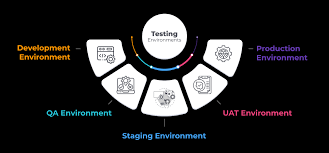Every release, feature, or bug fix relies on environments that support development and testing. When environments are well organized, work moves forward with fewer interruptions, clearer communication, and stronger results.
Test environment management brings structure to these efforts. It ensures that environments are available when needed, used correctly, and maintained with care. Rather than reacting to environment-related issues, teams that follow structured practices stay focused on delivery.
Defining the Purpose of Each Environment
Clarity begins with naming and purpose. Different types of testing call for different setups, configurations, and data states. Defining each environment’s role helps teams prepare for testing without second-guessing availability or configuration.
Common environment types include:
- Development – Active coding and local validation
- Integration – Service interaction and dependency testing
- Quality Assurance (QA) – Test execution and issue verification
- User Acceptance (UAT) – Business user validation
- Performance – Load and stress evaluation
A consistent environment structure supports parallel development efforts and helps maintain focus throughout the release cycle. Tools like Golive by Apwide offer visibility into all environments, allowing teams to assign purpose and track usage with ease.
Coordinating Scheduling and Reservations
Environments are often shared across teams. Scheduling their use helps prevent conflicts and delays. Test environment management benefits greatly from clear booking processes and real-time status updates.
Key elements of efficient scheduling:
- Shared environment calendar
- Booking requests and approvals
- Automated usage reminders
- Conflict alerts and change tracking
With Golive, teams can manage bookings directly inside Jira, reducing dependency on spreadsheets or side channels for updates.
Keeping Configurations Consistent
Testing relies on reproducibility. When environments are consistent, test results become more meaningful and comparisons more accurate.
Helpful practices include:
- Infrastructure as code for provisioning
- Version control for configurations and dependencies
- Environment-specific setup templates
- Automated post-deployment validation checks
Consistency reduces uncertainty and helps developers troubleshoot based on actual behavior, not environmental discrepancies.
Managing Test Data with Intention
The right data makes testing meaningful. Whether you’re verifying a calculation or checking user permissions, realistic data creates more accurate outcomes.
Tips for effective test data management:
- Use anonymized data from production where possible
- Refresh data regularly across environments
- Create reusable datasets for common testing scenarios
- Isolate data for test cases that need custom setups
Test data planning improves environment value and supports more reliable testing outcomes. Integrating this with your environment tracking—such as through Golive—adds even more structure.
Improving Communication Across Teams
Environment-related questions often delay progress. A clear communication framework can prevent this and reduce misunderstandings.
Suggested practices:
- Real-time dashboards for environment status
- Change logs and event history
- Centralized documentation for each environment
- Environment contact or owner assignment
When environment information is easy to find, developers and testers spend less time tracking down answers and more time delivering results.
Observing and Adapting Over Time
As teams grow and projects shift, environment needs evolve. Observing patterns in usage, incidents, and delays can guide smart improvements to your approach.
Points to review regularly:
- How often environments are used versus planned
- Repeated environment-related blockers
- Number of parallel testing efforts supported
- Feedback from developers, testers, and business users
Periodic reviews make test environment management a living part of your delivery process—not just background support. With tools like Golive, these insights are already available where your teams work.
Supporting Growth Without Complexity
Whether supporting one team or several departments, test environment management should scale without adding unnecessary complexity. A thoughtful approach provides structure, reduces manual coordination, and keeps environments ready for use.
Teams that prioritize test environment management build more than systems—they support momentum, accountability, and shared understanding. With visibility and tools like Golive from Apwide, developers and testers can plan, execute, and adjust with confidence at every step.
READ ALSO: Oven Baked Potatoes That Impress: Tips And Tricks


